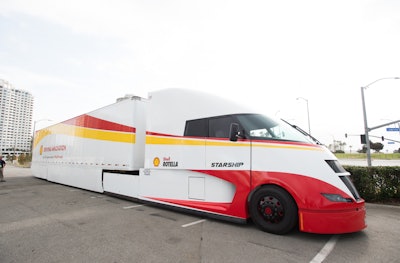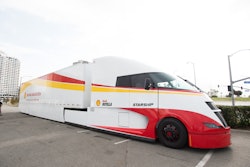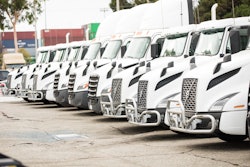 Shell’s original take on the Starship concept tractor-trailer ran a 2,410-mile run last May from San Diego to Jacksonville, Florida. The company plans to perform a similar test with an updated Starship next year.
Shell’s original take on the Starship concept tractor-trailer ran a 2,410-mile run last May from San Diego to Jacksonville, Florida. The company plans to perform a similar test with an updated Starship next year.The Shell Lubricants’ Starship concept tractor-trailer, which achieved nearly 9 mpg while carrying roughly 20 tons of cargo last year during a cross-country trek, will be hitting the road again next year with some improvements gleaned from last year’s run.
Bob Mainwaring, Shell Lubricants technology manager and the technology lead for Starship, said the company plans to make the truck more aerodynamic and to overhaul its drivetrain, among other changes. Mainwaring spoke earlier this month at a Shell Lubricants press event in Barcelona, Spain.
“There were things on version one that we weren’t too happy with,” Mainwaring said. “Some of the aerodynamic bits could work better than they did so we’re refining those. We’re in discussion at the moment about the best combination of engine and transmission to use.”
The original Starship was developed from 2014 through 2018. Notable aerodynamic features were designed by AirFlow, while Cummins provided a prototype 6-cylinder X15 engine that was mated to an 18-speed Eaton AMT transmission with a custom calibrated Transmission Electronic Control Unit (TECU).
“I think that’s been rather refined now so the integration through its electronic control unit with the transmission system that we propose to use has gained refinement there,” Mainwaring said. “(There will be) modification to a more efficient transmission which happens to be a lighter transmission as well that will let us get more goods in for a lower truck weight.”
Adaptive cruise control proved to be a challenging goal that didn’t pan out as planned during last year’s 2,410-mile trip chiefly made on Interstate 10 from San Diego, Calif. to Jacksonville, Fla.
“You can imagine the challenge of setting up things like adaptive cruise control—which some of these trucks have—on a truck that’s as novel as that was really rather ambitious for us,” Mainwaring said. “We didn’t make that work as well as we had hoped. So for 2020 we want that to be in place again.”
Mainwaring recalled the success of last year’s Starship run and compared its performance to an average truck in the U.S.
“There are roughly 2 million heavy-duty trucks in the U.S. Typically they’re loaded to 11 ¼ tons of cargo. Full capacity would be closer to 20 tons. They have an average fuel economy of 6.4 miles per U.S. gallon,” Mainwaring explained. “By contrast, the Starship was loaded to almost 20 tons and despite the fact that it was loaded to that level, it achieved almost 9 miles per gallon.”
Mainwaring also referred to Starship’s freight ton efficiency metric which is 178-ton miles per gallon (19.9 tons of freight multiplied by 8.94 mpg) while the average U.S. truck, he said, has a freight-ton efficiency of 72 ton miles per gallon (11.25 tons of freight multiplied by 6.4 mpg).
“That’s almost 2 ½ times better,” Mainwaring said. “You can do that today with those technologies.”
Starship uses the following technologies to improve mpg while reducing CO2 emissions by up to 60 percent: roof-mounted solar panels to power interior accessories with the engine off; a 6×2 axle-ratio lowered weight, reduced friction and improved fuel economy; aerodynamic improvements to lessen wind resistance; predictive cruise control and regenerative braking; low viscosity, full synthetic Shell lubricants to reduce friction; low rolling resistance single-wide tires; active grille cooling system which closes when cooling is not needed; an ultra-low RPM transmission.
The next Starship trip is set for the middle of next year and will run the same 2,410-mile route along I-10 from California to Florida. There’s no mpg target set, Mainwaring said, other than “to be better than before.”












